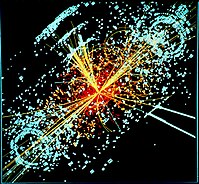
Photo from wikipedia
A bstractAsymmetric dark matter (ADM) is an attractive framework relating the observed baryon asymmetry of the Universe to the dark matter density. A composite particle in a new strong dynamics… Click to show full abstract
A bstractAsymmetric dark matter (ADM) is an attractive framework relating the observed baryon asymmetry of the Universe to the dark matter density. A composite particle in a new strong dynamics is a promising candidate for ADM as the strong dynamics naturally explains the ADM mass in the GeV range. Its large annihilation cross section due to the strong dynamics leaves the asymmetric component to be dominant over the symmetric component. In such composite ADM scenarios, the dark sector has a relatively large entropy density in the early Universe. The large dark sector entropy results in the overclosure of the Universe or at best contradicts with the observations of the cosmic microwave background and the successful Big-Bang Nucleosynthesis. Thus, composite ADM models generically require some portal to transfer the entropy of the dark sector into the Standard Model sector. In this paper, we consider a dark photon portal with a mass in the sub-GeV range and kinetic mixing with the Standard Model photon. We investigate the viable parameter space of the dark photon in detail, which can find broad applications to dark photon portal models. We also provide a simple working example of composite ADM with a dark photon portal. Our model is compatible with thermal leptogenesis and B − L symmetry. By taking into account the derived constraints, we show that the parameter space is largely tested by direct detection experiments.
Journal Title: Journal of High Energy Physics
Year Published: 2018
Link to full text (if available)
Share on Social Media: Sign Up to like & get
recommendations!